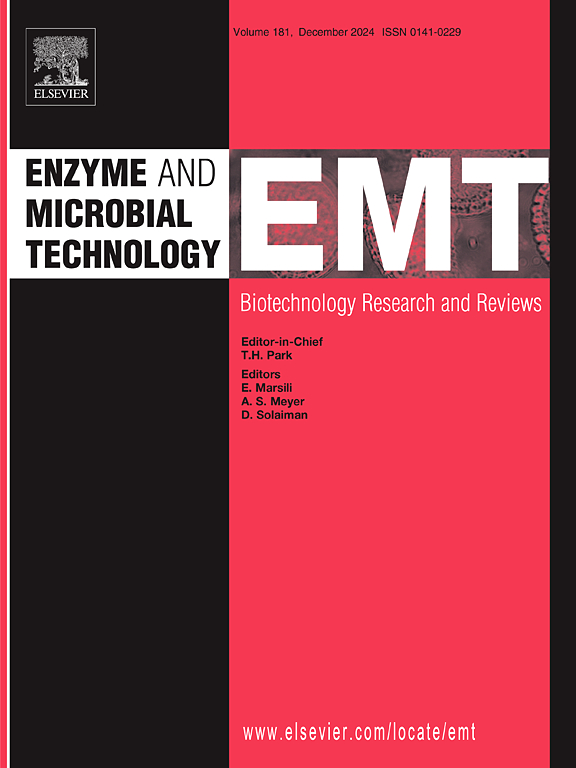Identification of a bacteria P450 enzyme from B. megaterium H-1 with vitamin D3 C-25 hydroxylation capabilities
IF 3.4
3区 生物学
Q2 BIOTECHNOLOGY & APPLIED MICROBIOLOGY
引用次数: 0
Abstract
Calcidiol (25(OH)VD3) and calcitriol (1α,25(OH)2VD3) are active vitamin D3 with high medicinal value, which can maintain calcium and phosphorus balance and treat vitamin D deficiency. Microbial synthesis is an important method to produce high-value-added compounds. It can produce active vitamin D3 through the hydroxylation reaction of P450, which can reduce the traditional chemical synthesis steps, and greatly improve the production efficiency and economic benefits. In this work, Bacillus megaterium H-1 was screened for its ability to produce 25(OH)VD3 and 1α,25(OH)2VD3 from vitamin D3. A new highly inducible vitamin D3 hydroxylase CYP109E1-H was identified from B. megaterium H-1 through searching for transcripts with cytochrome P450 structural domains, combining the transcriptome sequencing with functional expression in Bacillus subtilis WB600. Biotransformation in recombinant B. subtilis confirmed that CYP109E1-H has C-25 hydroxylase activity towards vitamin D3. CYP109E1-H is a natural mutant of CYP109E1 with greater stereoselectivity and it is a new vitamin D3 mono-hydroxylase. The cloning and characterization of the CYP109E1-H gene provide useful information on the structural basis for improving the regional and stereoselectivity of the CYP109E gene.
具有维生素D3 C-25羟基化能力的巨型芽孢杆菌H-1细菌P450酶的鉴定。
钙二醇(25(OH)VD3)和骨化三醇(1α,25(OH)2VD3)是具有较高药用价值的活性维生素D3,可维持钙磷平衡,治疗维生素D缺乏症。微生物合成是生产高附加值化合物的重要方法。通过P450的羟基化反应可以生产活性维生素D3,减少了传统的化学合成步骤,大大提高了生产效率和经济效益。本研究筛选了巨芽孢杆菌H-1从维生素D3中产生25(OH)VD3和1α,25(OH)2VD3的能力。通过寻找含有细胞色素P450结构域的转录本,结合转录组测序和枯草芽孢杆菌WB600的功能表达,从巨芽孢杆菌H-1中鉴定出一个新的高诱导性维生素D3羟化酶CYP109E1-H。在重组枯草芽孢杆菌中的生物转化证实了CYP109E1-H对维生素D3具有C-25羟化酶活性。CYP109E1- h是CYP109E1的天然突变体,具有较高的立体选择性,是一种新的维生素D3单羟化酶。CYP109E1-H基因的克隆和鉴定为提高CYP109E基因的区域选择性和立体选择性提供了有益的结构依据。
本文章由计算机程序翻译,如有差异,请以英文原文为准。
求助全文
约1分钟内获得全文
求助全文
来源期刊

Enzyme and Microbial Technology
生物-生物工程与应用微生物
CiteScore
7.60
自引率
5.90%
发文量
142
审稿时长
38 days
期刊介绍:
Enzyme and Microbial Technology is an international, peer-reviewed journal publishing original research and reviews, of biotechnological significance and novelty, on basic and applied aspects of the science and technology of processes involving the use of enzymes, micro-organisms, animal cells and plant cells.
We especially encourage submissions on:
Biocatalysis and the use of Directed Evolution in Synthetic Biology and Biotechnology
Biotechnological Production of New Bioactive Molecules, Biomaterials, Biopharmaceuticals, and Biofuels
New Imaging Techniques and Biosensors, especially as applicable to Healthcare and Systems Biology
New Biotechnological Approaches in Genomics, Proteomics and Metabolomics
Metabolic Engineering, Biomolecular Engineering and Nanobiotechnology
Manuscripts which report isolation, purification, immobilization or utilization of organisms or enzymes which are already well-described in the literature are not suitable for publication in EMT, unless their primary purpose is to report significant new findings or approaches which are of broad biotechnological importance. Similarly, manuscripts which report optimization studies on well-established processes are inappropriate. EMT does not accept papers dealing with mathematical modeling unless they report significant, new experimental data.
 求助内容:
求助内容: 应助结果提醒方式:
应助结果提醒方式:


